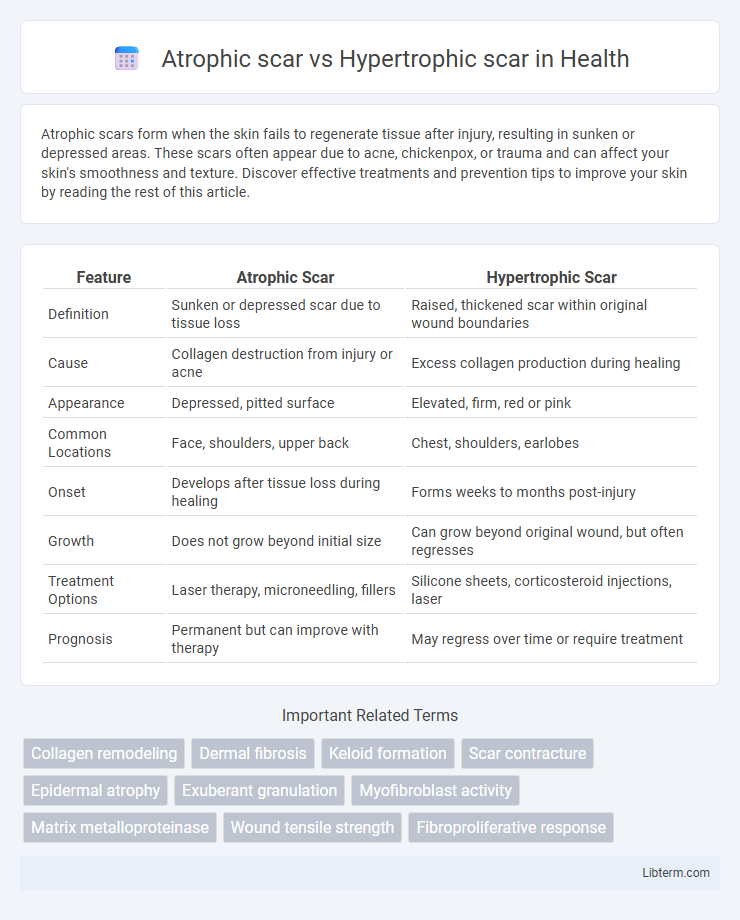Atrophic scars form when the skin fails to regenerate tissue after injury, resulting in sunken or depressed areas. These scars often appear due to acne, chickenpox, or trauma and can affect your skin's smoothness and texture. Discover effective treatments and prevention tips to improve your skin by reading the rest of this article.
Table of Comparison
| Feature | Atrophic Scar | Hypertrophic Scar |
|---|---|---|
| Definition | Sunken or depressed scar due to tissue loss | Raised, thickened scar within original wound boundaries |
| Cause | Collagen destruction from injury or acne | Excess collagen production during healing |
| Appearance | Depressed, pitted surface | Elevated, firm, red or pink |
| Common Locations | Face, shoulders, upper back | Chest, shoulders, earlobes |
| Onset | Develops after tissue loss during healing | Forms weeks to months post-injury |
| Growth | Does not grow beyond initial size | Can grow beyond original wound, but often regresses |
| Treatment Options | Laser therapy, microneedling, fillers | Silicone sheets, corticosteroid injections, laser |
| Prognosis | Permanent but can improve with therapy | May regress over time or require treatment |
Understanding Atrophic and Hypertrophic Scars
Atrophic scars result from the loss of underlying fat or collagen, causing a sunken or depressed appearance commonly seen in acne or chickenpox scars. Hypertrophic scars, in contrast, are characterized by excessive collagen production leading to raised, thickened scar tissue confined to the original wound boundaries. Understanding the distinct collagen remodeling processes and skin responses in atrophic versus hypertrophic scars is crucial for selecting effective treatment options like microneedling for atrophic scars or silicone sheets for hypertrophic scars.
Causes of Atrophic Scars
Atrophic scars result from the loss of collagen during the healing process, often caused by acne, chickenpox, or trauma that damages the deeper layers of skin. Unlike hypertrophic scars, which are raised due to excessive collagen deposition, atrophic scars appear sunken or pitted with a thin epidermis. Factors such as inflammation, delayed wound healing, and genetic predisposition contribute significantly to the formation of atrophic scars.
Causes of Hypertrophic Scars
Hypertrophic scars result from excessive collagen production during the wound healing process, often triggered by factors such as skin trauma, burns, surgical incisions, or infections. These scars remain confined to the original wound boundary but can appear raised, red, and thickened due to persistent inflammation or prolonged tension on the healing skin. Unlike atrophic scars, which are characterized by tissue loss and indentation, hypertrophic scars signify an overactive healing response leading to tissue overgrowth.
Key Differences: Atrophic vs Hypertrophic Scars
Atrophic scars are characterized by sunken, depressed areas caused by collagen loss during wound healing, commonly seen in acne or chickenpox scars. Hypertrophic scars result from excessive collagen production, leading to raised, thickened, and often red scars confined within the original wound boundaries. Unlike hypertrophic scars, atrophic scars lack excessive tissue formation and appear indented due to tissue deficit.
Clinical Appearance and Identification
Atrophic scars present as depressed, thin, and sunken areas of skin resulting from a loss of underlying tissue, commonly seen in conditions like acne or chickenpox. Hypertrophic scars appear as raised, red, and thickened lesions confined within the original wound boundaries, characterized by excessive collagen deposition during the healing process. Clinically, atrophic scars are identified by their concave texture and skin thinning, while hypertrophic scars are distinguished by their elevated, firm, and erythematous appearance.
Common Examples and Associated Conditions
Atrophic scars commonly result from acne, chickenpox, or surgery, characterized by sunken, pitted skin due to collagen loss. Hypertrophic scars often arise from burns, surgical wounds, or traumatic injuries, presenting as raised, thickened tissue confined to the original wound boundary. Conditions such as keloids are related but differ by extending beyond the wound site, while hypertrophic scars remain within the injury margins.
Risk Factors and Predisposing Conditions
Atrophic scars develop due to the loss of underlying fat or collagen, commonly linked with acne, chickenpox, or surgical wounds, while hypertrophic scars result from excessive collagen production during wound healing, often triggered by trauma, burns, or piercings. Risk factors for atrophic scars include genetic predisposition to poor collagen synthesis, skin infections, and delayed wound closure, whereas hypertrophic scars are more common in individuals with darker skin tones, younger age, and a history of keloid formation. Both scar types are influenced by inflammation severity, wound tension, and anatomical location, with areas subjected to high movement or tension presenting increased risk for abnormal scar formation.
Diagnostic Techniques for Scar Types
Diagnostic techniques for differentiating atrophic scars from hypertrophic scars primarily involve clinical examination and advanced imaging modalities. Atrophic scars, characterized by tissue loss and skin depression, are typically assessed using 3D imaging and optical profilometry to measure scar depth and surface irregularities. Hypertrophic scars, defined by excessive collagen deposition leading to raised and firm tissue, are evaluated through ultrasound elastography and histopathological biopsy to determine collagen density and scar thickness.
Treatment Options for Atrophic Scars
Atrophic scars, characterized by sunken or pitted skin due to collagen loss, respond well to treatments like microneedling, laser therapy (fractional CO2 and erbium lasers), and chemical peels that stimulate collagen production and promote skin remodeling. Dermal fillers, such as hyaluronic acid, offer immediate volume restoration for deeper atrophic scars, while subcision breaks down fibrotic strands tethering the scar to underlying tissue. Topical retinoids and platelet-rich plasma (PRP) therapy further enhance skin texture and collagen synthesis, providing effective options distinct from treatments used for hypertrophic scars, which typically require pressure therapy, silicone sheets, or corticosteroid injections to reduce raised scar tissue.
Treatment Strategies for Hypertrophic Scars
Hypertrophic scars require targeted treatment strategies such as silicone gel sheets, corticosteroid injections, and laser therapy to reduce collagen production and improve scar appearance. Pressure therapy and cryotherapy can also be effective in minimizing scar thickness and redness. Early intervention combined with consistent follow-up enhances treatment outcomes for hypertrophic scars compared to atrophic scars, which typically need different approaches like fillers or microneedling.
Atrophic scar Infographic

 libterm.com
libterm.com